![]()
![]()
![]()
Use LEFT and RIGHT arrow keys to navigate between flashcards;
Use UP and DOWN arrow keys to flip the card;
H to show hint;
A reads text to speech;
129 Cards in this Set
- Front
- Back
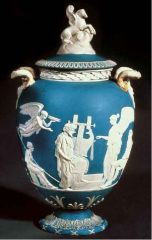
Flaxman's low relief work
|

Wedgwood jasperware
|
|
|
experiments with color and composition
|
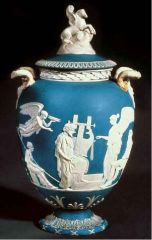
Wedgwood jasperware
|
|
|
Scene = Iliad & the Odyssey
|
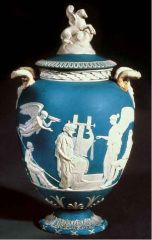
Wedgwood jasperware
|
|
|
very fine ground materials
|
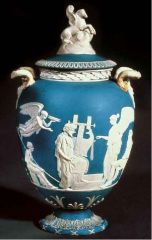
Wedgwood jasperware
|
|
|
ordered by queen charlotte
|
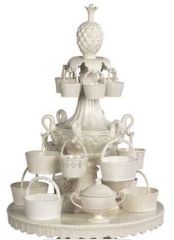
Wedgwood creamware
|
|
|
Neo-classical | also called Queen's ware
|
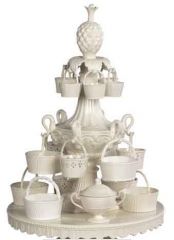
Wedgwood creamware
|
|
|
Restrained looking | Revolutionary
|
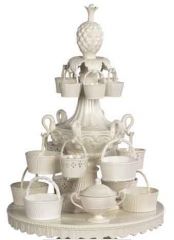
Wedgwood creamware
|
|
|
Distribution was essential to the movement, anti-slavery society
|
Wedgwood
anti-slavery medallion |
|
|
one of the first fashion items to support a cause
|
Wedgwood
anti-slavery medallion |
|
|
Quotes history of the piece
|
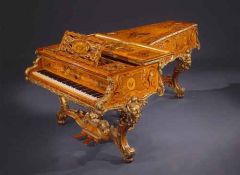
Grand pianoforte
|
|
|
possession allowed the middle class access to higher culture
|
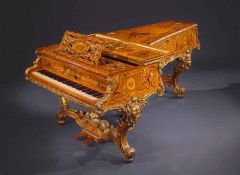
Grand pianoforte
|
|
|
built in the short span of 6 months
|
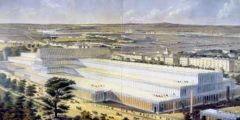
Joseph Paxton, Crystal Palace
|
|
|
housed the great exhibition of all nations
|
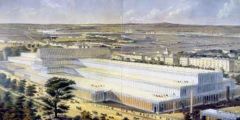
Joseph Paxton, Crystal Palace
|
|
|
Center peiece of the Desfosse exhibit at the Paris Universal Exhibition
|

Desfossé Wallpaper Company,
Garden of Armida wallpaper, Paris, c. 1851 |
|
|
Painted by Edouard Muller
|
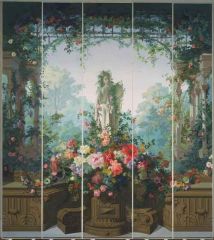
Desfossé Wallpaper Company,
Garden of Armida wallpaper, Paris, c. 1851 |
|
|
Example of inspiration to take wallpaper to a level of fine art
|
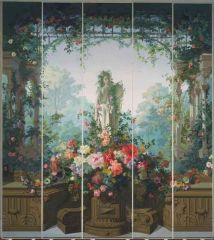
Desfossé Wallpaper Company,
Garden of Armida wallpaper, Paris, c. 1851 |
|
|
Wanted to spread art to the “most modern interiors”
|
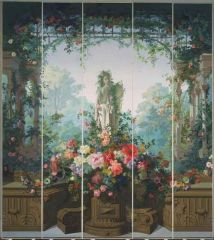
Desfossé Wallpaper Company,
Garden of Armida wallpaper, Paris, c. 1851 |
|
|
1830's = the age of wallpaper
|
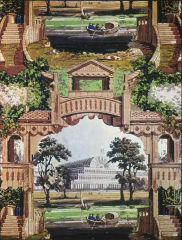
Machine-made (steam-
roller process) wallpaper, c. 1853–55 |
|
|
the poor had the means of acquiring nice wallpaper
|
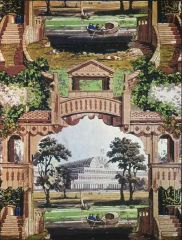
Machine-made (steam-
roller process) wallpaper, c. 1853–55 |
|
|
cheaply produced wallpaper meant more designs
|
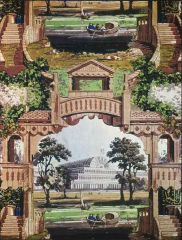
Machine-made (steam-
roller process) wallpaper, c. 1853–55 |
|
|
existed side by side with hand-block process
|
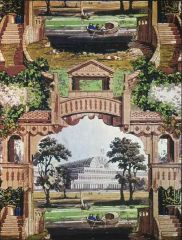
Machine-made (steam-
roller process) wallpaper, c. 1853–55 |
|
|
new technologies such as electroplating
|

Sheffield Steel, Great Exhibition, London, 1851
|
|
|
explosion of mass production of household goods such as iron stoves, tableware, and lighting fixtures
|
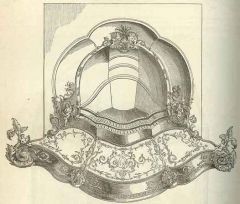
Sheffield Steel, Great Exhibition, London, 1851
|
|
|
required a proficiency in art for metal working
|
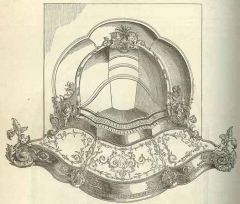
Sheffield Steel, Great Exhibition, London, 1851
|
|
|
universality of standards that can form the basis for all designers
|
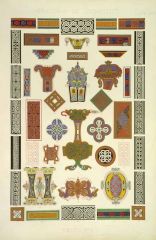
Page from Owen Jones’s
The Grammar of Ornament, (London, 1856) |
|
|
based upon an observation form in nature
|
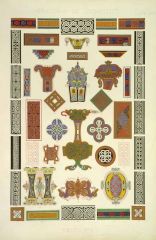
Page from Owen Jones’s
The Grammar of Ornament, (London, 1856) |
|
|
curved arches to enrich support
|
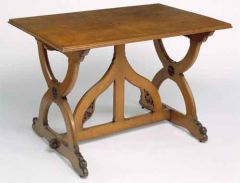
Augustus Pugin, gothic-style dining room table, c. 1845
|
|
|
repetition & symmetry, crisp contours and flat shapes
|
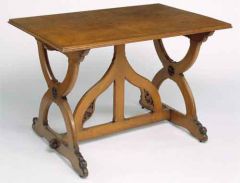
Augustus Pugin, gothic-style dining room table, c. 1845
|
|
|
Furnishings established a link minimally with craft traditions
|
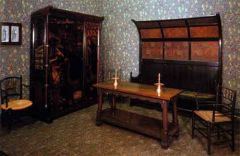
William Morris, wardrobe, settee, table and chairs, 1860s
|
|
|
Individuals expression inspired designs from earlier period like the middle ages.
|
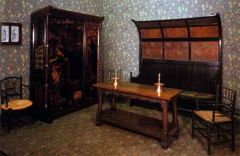
William Morris, wardrobe, settee, table and chairs, 1860s
|
|
|
Intended to convey the love of nature & appreciation of craftsmanship
|
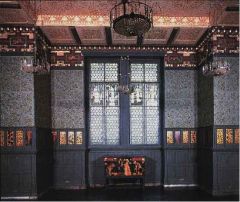
William Morris lunchroom
|
|
|
Lunch room for visitors, with painted vine scroll pattern
|

William Morris lunchroom
|
|
|
formal simplicity inspired by medieval art
|
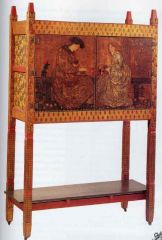
Philip Webb,
backgammon cabinet with figures painted after a drawing by Edward Burne-Jones, 1861. |
|
|
simple/abstract geometric motifs
|
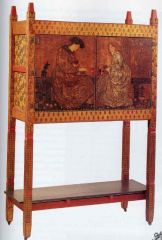
Philip Webb,
backgammon cabinet with figures painted after a drawing by Edward Burne-Jones, 1861. |
|
|
Love of nature in ornament
|
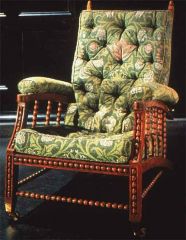
William Morris, chair,
c. 1870 |
|
|
Outlet for the skill and invention of the craftsman
|
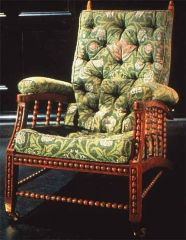
William Morris, chair,
c. 1870 |
|
|
Primarily used for ceramic tiles embroideries, wallpapers, printed fabrics
|
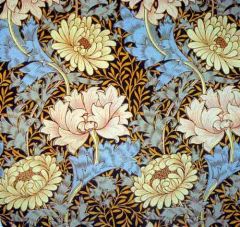
Examples of Morris & Co. wallpaper patterns, 1876
|
|
|
Decoration was viewed as an embellishment to construction
|
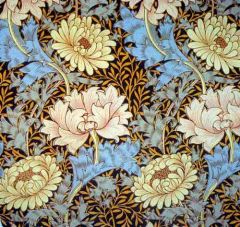
Examples of Morris & Co. wallpaper patterns, 1876
|
|
|
Morris experimented with vegetable dyes
|
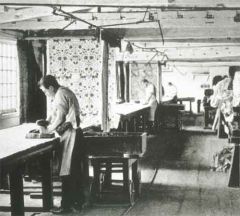
Hand-printing wallpaper in William Morris’s workshop, last quarter of the 19th century
|
|
|
Refused to use machines for manufacture of wallpapers or printed fabrics
|
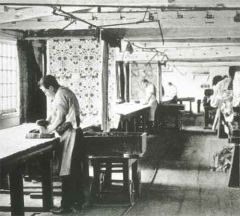
Hand-printing wallpaper in William Morris’s workshop, last quarter of the 19th century
|
|
|
Morris drew the typefaces himself
|
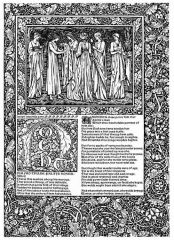
William Morris and
Edward Burne-Jones, Kelmscott Chaucer, 1896. Page from “The Clerk’s Tale” |
|
|
The book itself = an object of beauty
|
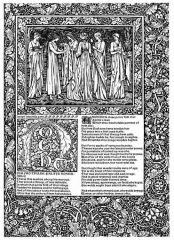
William Morris and
Edward Burne-Jones, Kelmscott Chaucer, 1896. Page from “The Clerk’s Tale” |
|
|
Decorative richness and illustrated pages attracted a high-end clientele
|
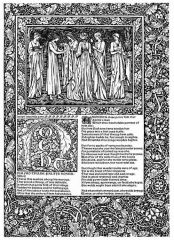
William Morris and
Edward Burne-Jones, Kelmscott Chaucer, 1896. Page from “The Clerk’s Tale” |
|
|
Designed by William Morris | Morris drew the typeface himself
|

William Morris
|
|
|
Dore focus on poverty in London
|
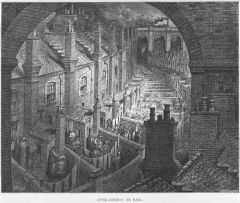
Gustave Doré, London, a Pilgrimage:
Over London by Rail, 1872 |
|
|
Critically accused of inventing poverty instead of copying what was really happening in London
|
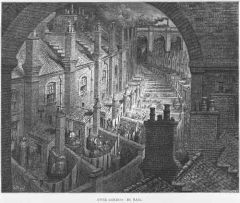
Gustave Doré, London, a Pilgrimage:
Over London by Rail, 1872 |
|
|
Focus on middle class leisure
|
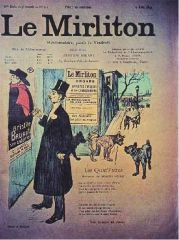
poster
|
|
|
Less structured form of self expression
|

poster
|
|
|
Integration of text and image approach to create unified design
|

Jules Chéret, Olympia, 1893
|
|
|
Sense of movement
|

Jules Chéret, Olympia, 1893
|
|
|
scenes of love and voluptuousness
|
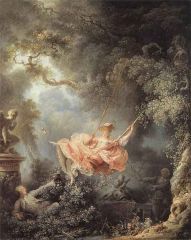
Fragonard, The Swing, 1767
|
|
|
tender beauty of his color and the virtuosity of his brushwork
|
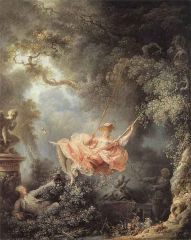
Fragonard, The Swing, 1767
|
|
|
Purpose of Cheret was to create a world of explosive happiness
|
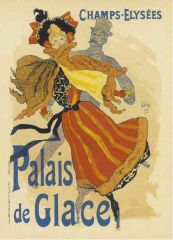
Charet Poster
|
|
|
Posters represent the ancestor of modern advertising
|
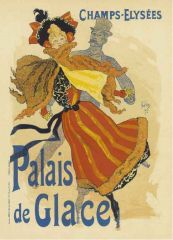
Charet Poster
|
|
|
Mucha was a key figure in the Art Nouveau movement
|
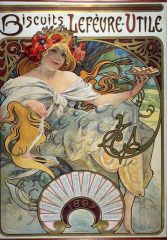
Mucha (Czech),
LU cookie poster, 1896 |
|
|
he always insisted that rather than adhering to any fashionable stylistic form
|
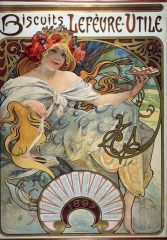
Mucha (Czech),
LU cookie poster, 1896 |
|
|
Simplified with strong contours
|
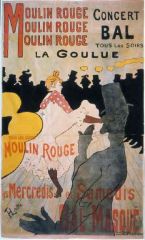
Henri de Toulouse-Lautrec, Moulin Rouge, La Goulue, 1891. Lithograph
|
|
|
Sets the mood for night life
|
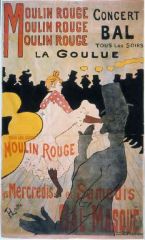
Henri de Toulouse-Lautrec, Moulin Rouge, La Goulue, 1891. Lithograph
|
|
|
Young, progressive people were particularly keen on a more mobile way of life
|

Poster by
Steinlen |
|
|
show amusingly what happens when progress intrudes on rustic tranquility
|

Poster by
Steinlen |
|
|
Combined romance with Art Nouveau
|
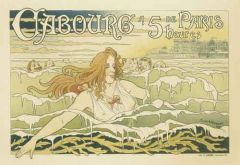
Privat-Livement, ad for seaside resort 5 hours from Paris, 1896
|
|
|
excellent example of female sensuality
|
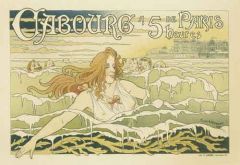
Privat-Livement, ad for seaside resort 5 hours from Paris, 1896
|
|
|
paintings were one strand in the evolving tapestry of Aestheticism
|

Edward Burne-Jones,
The Depths of the Sea, 1886 |
|
|
art should be valued as an object of beauty engendering a sensual response
|

Edward Burne-Jones,
The Depths of the Sea, 1886 |
|
|
Ideals resolutely pursued are apt to provoke the resentment of the world
|
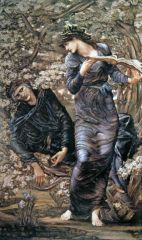
Burne-Jones,
The Beguiling of Merlin, 1874 |
|
|
balance between aesthetics and function
|
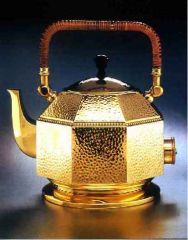
Peter Behrens for AEG, electric tea kettle, c. 1908–12
|
|
|
Promoting the use of electricity for cooking
|
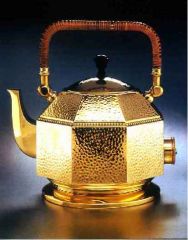
Peter Behrens for AEG, electric tea kettle, c. 1908–12
|
|
|
Resembling hand hammered surfaces
|
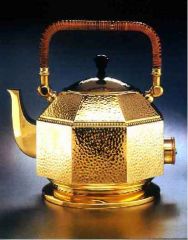
Peter Behrens for AEG, electric tea kettle, c. 1908–12
|
|
|
Energetic lines that integrate illustrative elements
|
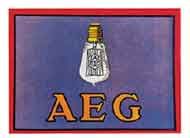
Otto Eckmann,
AEG catalogue cover, 1900 Art nouveau style (“Jugendstil” in German) |
|
|
Anticipated the use of corporate identity programs
|
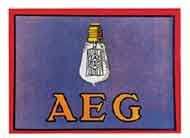
Peter Behrens AEG logo,
circa 1912 |
|
|
Consistent typeface layout
|
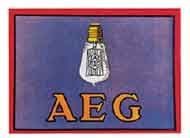
Otto Eckmann,
AEG catalogue cover, 1900 Art nouveau style (“Jugendstil” in German) |
|
|
Universal spiritual expression
|
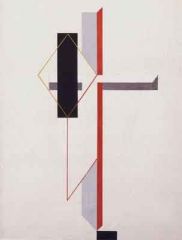
El Lissitsky, Proun,
c. 1922 |
|
|
Use of abstract art as a means to a political end
|
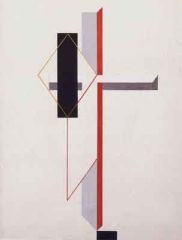
El Lissitsky, Proun,
c. 1922 |
|
|
Rectangular reading room
|
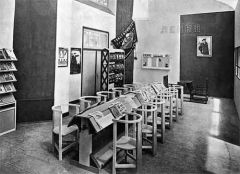
Alexander Rodchenko, Soviet Workers’ Club, exhibited at the International Exposition of Modern and Industrial Arts, Paris, 1925
|
|
|
Built from 8 standardized components
|
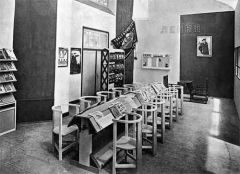
Alexander Rodchenko, Soviet Workers’ Club, exhibited at the International Exposition of Modern and Industrial Arts, Paris, 1925
|
|
|
Emphasis on standardized interchangeable components for furniture
|
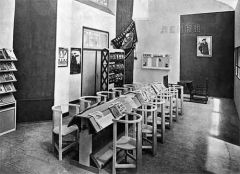
Alexander Rodchenko, Soviet Workers’ Club, exhibited at the International Exposition of Modern and Industrial Arts, Paris, 1925
|
|
|
Best known De-Stijl project
|
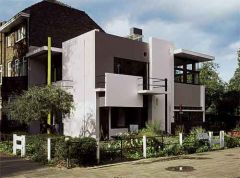
Gerrit Rietveld, Schröder House, Utrecht,
The Netherlands, 1925 |
|
|
Folding and sliding partitions
|
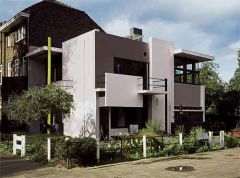
Gerrit Rietveld, Schröder House, Utrecht,
The Netherlands, 1925 |
|
|
Living work of non-objective art
|
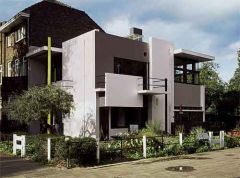
Gerrit Rietveld, Schröder House, Utrecht,
The Netherlands, 1925 |
|
|
Simple construction and void of luxury
|
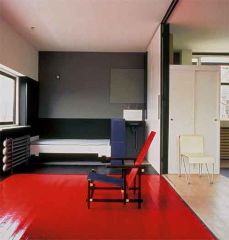
Interior view,
Schröder House, with red/blue armchair by architect Gerrit Rietveld |
|
|
modernist principle that form reflects function
|
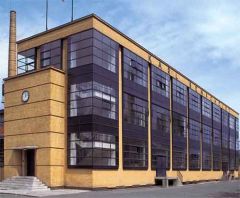
Walter Gropius and Adolf Meyer, Fagus Shoe Factory, Alfeld-an-der-Leine, Germany, 1911–16
|
|
|
providing healthful conditions for the working class
|
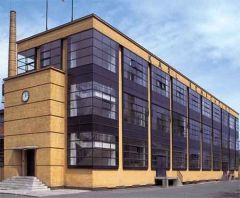
Walter Gropius and Adolf Meyer, Fagus Shoe Factory, Alfeld-an-der-Leine, Germany, 1911–16
|
|
|
geometrical performance as rooted in nature
|
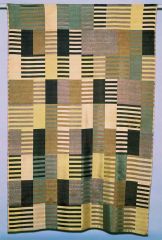
Anni Albers,
wall hanging, 1926. Silk two-ply weave, approx 6’ x 4’ |
|
|
simple basic pattern could generate variety
|

Anni Albers,
wall hanging, 1926. Silk two-ply weave, approx 6’ x 4’ |
|
|
Used a variety of sizes to reflect the hierarchy for information
|
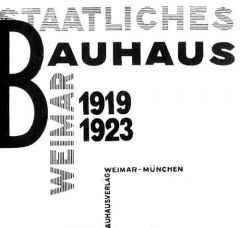
Laszlo Moholy-Nagy, Bauhaus typeface
|
|
|
New sense of the awareness for the white space of the page
|
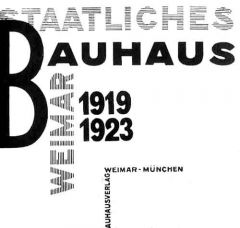
Laszlo Moholy-Nagy, Bauhaus typeface
|
|
|
String abstract shapes
|
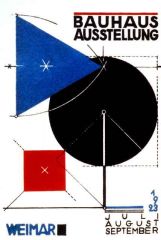
Herbert Bayer, Bauhaus exhibition postcard, 1923
|
|
|
Lettering for hierarchy of information
|

Herbert Bayer, Bauhaus exhibition postcard, 1923
|
|
|
Uses photo montage techniques extensively
|
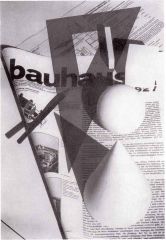
Herbert Bayer, Bauhaus (magazine cover), v.2: 2–3, 1928
|
|
|
Triggered viewer associations
|
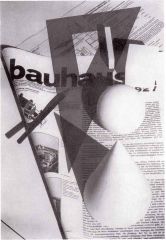
Herbert Bayer, Bauhaus (magazine cover), v.2: 2–3, 1928
|
|
|
Simplistic minimalist design using basic shapes
|

Josef Hartwig, Bauhaus chess set, 1923
|
|
|
Efficiency of living
|
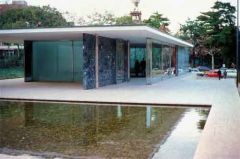
Ludwig Mies van der Rohe, German Pavillon, International Exposition, Barcelona, Spain, 1929 (rebuilt 1985–87)
|
|
|
Considered the glare and brightness of lighting
|
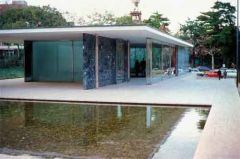
Ludwig Mies van der Rohe, German Pavillon, International Exposition, Barcelona, Spain, 1929 (rebuilt 1985–87)
|
|
|
Admired for purity and brilliance
|
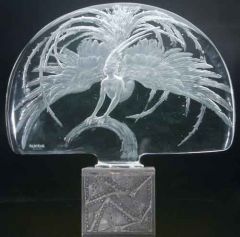
René Lalique, Firebird, c. 1925.
Acid-etched glass lamp with bronze base |
|
|
Plant like tail
|
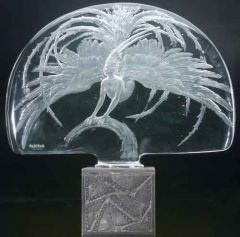
René Lalique, Firebird, c. 1925.
Acid-etched glass lamp with bronze base |
|
|
high-end style
|

Art Deco designs on 60 Wall Street, New york
|
|
|
elegant, glamorous, functional and modern.
|
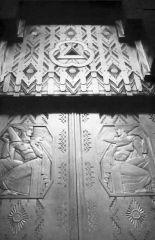
Art Deco designs on 60 Wall Street, New york
|
|
|
based on mathematical geometric shapes
|

Art Deco designs on 60 Wall Street, New york
|
|
|
Bold stencil forms
|
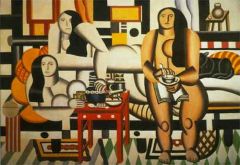
Fernand Léger, Three Women, 1921
|
|
|
Dramatic configurations of contrasting curves
|
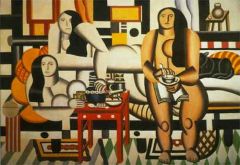
Fernand Léger, Three Women, 1921
|
|
|
High contrast
|
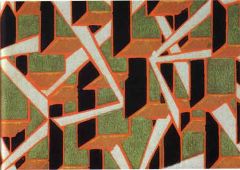
An Art Deco wallpaper pattern
|
|
|
Bold colors
|
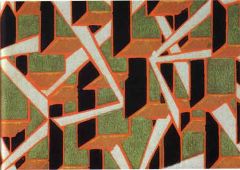
An Art Deco wallpaper pattern
|
|
|
3-d effect
|
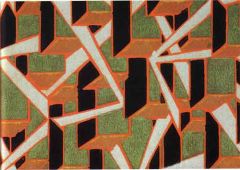
An Art Deco wallpaper pattern
|
|
|
is an Art Deco skyscraper
tower appeared physically and visually light as if floating on mid-air |

William Van Alen, Chrysler Building, New York, 1928–30
|
|
|
tower appeared physically and visually light as if floating on mid-air
|

William Van Alen, Chrysler Building, New York, 1928–30
|
|
|
the use of geometric patterns and linear designs that signified the modern look
|
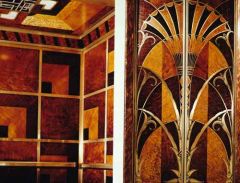
Chrysler Building interior veneers
|
|
|
Skyscraper style
|
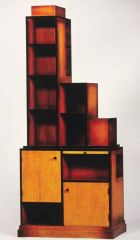
Paul Theodore Frankl, Art Deco skyscraper bookshelf,
1926 |
|
|
Set back profiles
|
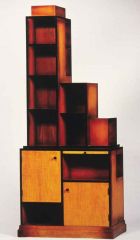
Paul Theodore Frankl, Art Deco skyscraper bookshelf,
1926 |
|
|
Tapered cylindrical forms
|
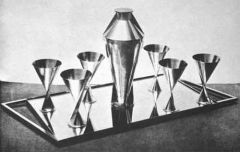
Art Deco cocktail service, 1926
|
|
|
very simple to drive, and easy and cheap to repair
|
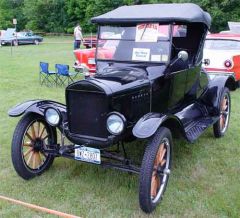
1924 Model-T Ford
|
|
|
1920s, a majority of American drivers had learned to drive on the Model T
|
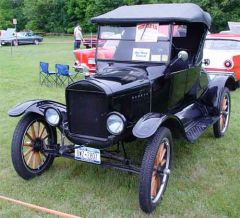
1924 Model-T Ford
|
|
|
such as reducing labor hours required to produce a single vehicle, and increased production numbers and parts
|
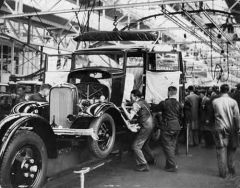
Ford assembly line, 1920s
|
|
|
Less expensive luxury sedan
|

Harley Earl 1927 Buick LaSalle
|
|
|
Low profile
|
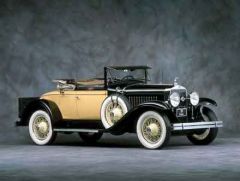
Harley Earl 1927 Buick LaSalle
|
|
|
Unified body design
|
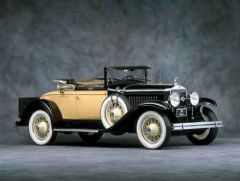
Harley Earl 1927 Buick LaSalle
|
|
|
Provided options in the cars without raising the cost
|
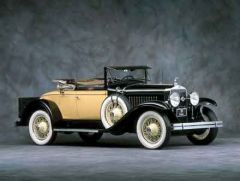
Harley Earl 1927 Buick LaSalle
|
|
|
Geometric forms
To attract attention in an abstract way |
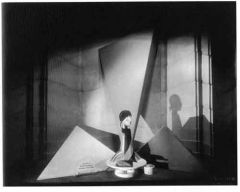
Norman Bel Geddes, art deco Franklin Simon department store window design, Fifth Avenue, NYC, 1928
|
|
|
Clean optimistic vision of democratic
|
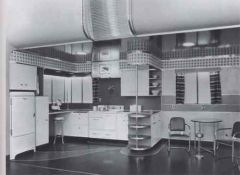
Bel Geddes, complete white Frigidaire kitchen,
New York World’s Fair, 1939 |
|
|
Emphasis with relationship with technology to increased leisure time
|
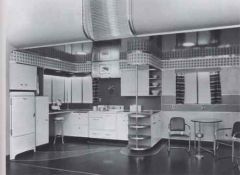
Bel Geddes, complete white Frigidaire kitchen,
New York World’s Fair, 1939 |
|
|
Bel Geddes, Standard Gas Equipment kitchen range, 1932
|
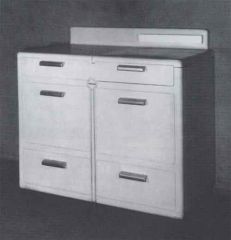
Bel Geddes, Standard Gas Equipment kitchen range, 1932
|
|
|
More enclosed unified box like form
|
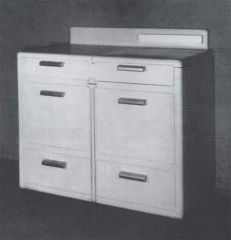
Bel Geddes, Standard Gas Equipment kitchen range, 1932
|
|
|
Eliminated open areas
|

Bel Geddes, Standard Gas Equipment kitchen range, 1932
|
|
|
Built for speed and lots of passengers
|
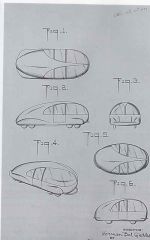
Bel Geddes, drawing for patent for
aerodynamically designed rear-engine auto, 1939 |
|
|
Smooth streamlined look suggestive of frictionless movement
|
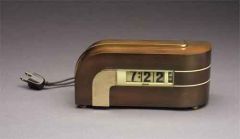
Kem Weber, Zephyr electric clock, 1934.
Brass, copper, bakelite, plastic |
|
|
Traffic flow was managed by multi-laned highways
|
Futurrama, 1939
|
|
|
Freudian Analysis (egos)
1. ID |
ID = basic instincts, unorganized part of the personality, unconscious, acting without the consideration of social norms or conformity
|
|
|
Freudian Analysis (egos)
2. Ego |
Ego = reality, drives in socially-acceptable ways
|
|
|
Freudian Analysis (egos)
3. Superego |
maintaining a sense of morality and preventing wrongdoing to a degree. It is literally guilt.
|
|
|
Freudian Analysis
|
1. Conscious: What an artifact does
2.Pre-conscious: other aspects of functionality 3. Unconscious: symbolic meaning |

